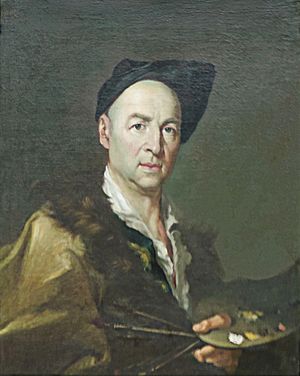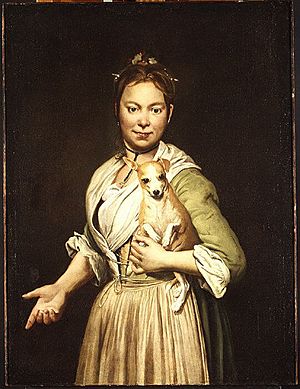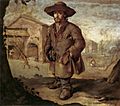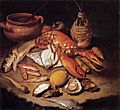Giacomo Ceruti facts for kids
Quick facts for kids
Giacomo Ceruti
|
|
|---|---|

Self-portrait, exhibit of the Pinacoteca di Brera
|
|
| Born |
Giacomo Antonio Melchiorre Ceruti
13 October 1698 |
| Died | 28 August 1767 (aged 68) |
| Nationality | Italian |
| Education | Carlo Ceresa |
| Known for | Painting |
| Movement | Baroque Genre |
Giacomo Antonio Melchiorre Ceruti (born October 13, 1698 – died August 28, 1767) was an Italian painter. He lived during the late Baroque period. Ceruti worked in Northern Italy, in cities like Milan, Brescia, and Venice.
He became known as Pitocchetto, which means "the little beggar." This nickname came from his many paintings of poor people dressed in old clothes.
Life and Training
Giacomo Ceruti was born in Milan, Italy. However, he spent most of his working life in Brescia. He learned how to paint from an artist named Carlo Ceresa. Ceruti was also likely influenced by other painters of his time.
Painting Everyday Life
Ceruti painted many different kinds of pictures. He created still lifes, which are paintings of objects. He also painted religious scenes for churches. But he is most famous for his "genre paintings." These are pictures that show scenes from everyday life.
He especially liked to paint beggars and poor people. He showed them in a very realistic way. His paintings gave these people a sense of importance and individuality. From about 1725 to 1740, Ceruti focused on these subjects. Around 50 of these paintings still exist today.
A writer named Mira Pajes Merriman studied Ceruti's work. She noted that his figures often "do almost nothing." This showed their difficult lives and lack of work. His paintings often show people who are homeless or very poor. They might be old or young, working with spindles. He also painted orphans, street children, and sick people. Many of them wore torn clothes and looked directly at the viewer.

One famous painting is his Woman with a Dog. It shows a simple subject with kindness. Ceruti did not try to make his subjects look perfect. Most of his figures are shown against a dark background. When he tried to paint deep landscapes, they sometimes looked a bit strange. His backgrounds often looked like stage sets. They were sometimes copied from engravings by artists like Jacques Callot.
Other Works
Ceruti's realistic style was also seen in his portraits. These are paintings of specific people. His still lifes also showed this realism. However, his decorative paintings for churches were more traditional. For example, he painted frescoes for the Basilica Santa Maria Assunta in Gandino. He also created an altarpiece for Santa Lucia in Padua. These religious works were not as unique as his genre paintings. Another painter, Giovanni Battista Moroni, was also known for his expressive portraits but less exciting religious art.
Gallery
-
Spinner Woman, Museo di Santa Giulia, Brescia
-
Porter Boy Resting (1736), Pinacoteca di Brera, Milan
See also
 In Spanish: Giacomo Ceruti para niños
In Spanish: Giacomo Ceruti para niños





















